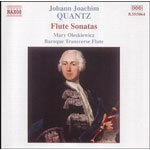
Quantz - Flute Sonatas
 $25.00
Out of Stock
$25.00
Out of Stock6+ weeks add to cart
Quantz - Flute Sonatas
Jean-Francois Beaudin, flute / Mary Oleskiewicz, flute / David Schulenberg, piano / Stephanie Vial, cello
[ Naxos / CD ]
Release Date: Tuesday 11 May 2004
This item is currently out of stock. It may take 6 or more weeks to obtain from when you place your order as this is a specialist product.
Johann Joachim Quantz was the most important flute virtuoso of the eighteenth century. Best known today for his Essay on Playing the Flute (Berlin, 1752), he wrote some two hundred sonatas for flute and continuo, about forty trio sonatas for two instruments and continuo, six quartets for flute, violin, viola and continuo, and some three hundred concertos for flute and strings.
Many of these works were composed for King Frederick II of Prussia, Frederick the Great, himself an accomplished flautist and composer whom Quantz taught and later served as royal court musician from 1741 until his death. In addition, the eight surviving flutes by Quantz were probably all made for King Frederick.
Before coming to Berlin Quantz had served the Saxon court in Dresden, where he played from 1718 first as a member of the Polish Chapel - the Elector of Saxony was also King of Poland - and from 1728 in the elite Hofkapelle. There he formed his distinctive style of playing and made the fundamental alteration in flute design for which he is most famous, the addition of a second key, which made it easier than on existing one-key flutes to play in a broad variety of tonalities. To this he later added a tuning slide in the head, further improving the tuning and the sound of the instrument. The striking qualities of Quantz's flutes, the ideal tone of which he described as "full, thick, round, and masculine", reflected the vocal timbres of the virtuoso Italian opera singers favoured in early eighteenth-century Dresden. This, together with the low French chamber pitch preferred by Quantz, enlivens his music with unusual warmth and vibrancy. The present release is the first recording of six of Quantz's Dresden solo and trio sonatas, performed on precise copies of the flutes he built and in the manner which he set forth in his Essay. The improvised keyboard continuo accompaniment employs fortepiano as well as harpsichord, since both instruments were known and used at Dresden and Berlin.
The English writer Charles Burney left a famous account of one of King Frederick's private flute concerts, during which only music by Quantz and the King was performed, and only Quantz enjoyed the privilege of congratulating (or criticizing) the King's playing. Burney's account, written at the very end of Quantz's career, encouraged a view of Quantz as a minor composer, restricted to a conservative pre-Classical or galant idiom, but, as these Dresden sonatas show, Quantz's music encompasses great variety, incorporating baroque fugues and dances, expressive chromaticism, and even imitations of operatic recitative, together with the graceful melodic writing and virtuoso passage-work that caught Burney's attention. The latter traits, inspired by the concertos of Vivaldi and the opera arias of Johann Adolph Hasse, the leading composer of opera at Dresden, and Quantz's friend, were sufficiently exciting during the 1720s and 1730s to inspire not only Quantz but J.S. Bach, whose later flute works show signs of having been composed with Quantz's music and instruments in mind.
Although it is impossible to attach precise dates to these works, none of which was published during Quantz's lifetime, the earliest may be the Sonata in G minor, QV 1:116. It is one of twenty sonatas preserved in a manuscript now in Berlin. Dating perhaps from around 1720, these pieces show the youthful composer testing his abilities by writing in all styles, genres, and keys. The sonata opens with an aria-like movement followed by a strict double fugue. The next movement, an obvious imitation of Italian recitative although not so marked, introduces a French-style minuet in the form of a rondeau. The Sonata in C, QV 1:9, must be a somewhat later work; its Handelian opening movement leads to an Allegro seemingly inspired by an aria in Hasse's opera Cleofide, first staged in Dresden in 1731.
Tracks:
Sonata in D major for transverse flute and basso continuo, QV 1:42
Sonata in G minor for transverse flute and basso continuo, QV 1:116
Trio Sonata in D major for two transverse flutes and basso continuo, QV 2:15
Sonata in C major for transverse flute and basso continuo, QV 1:9
Sonata in G minor for transverse flute and basso continuo, QV 1:28
Trio Sonata in E flat major for two transverse flutes and basso continuo, QV 2:17